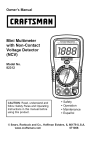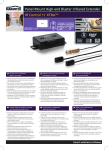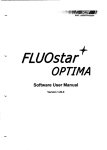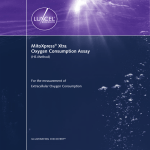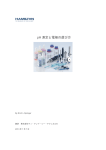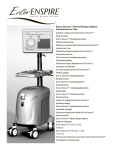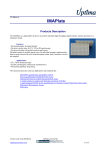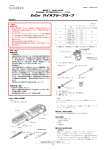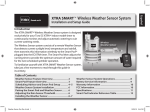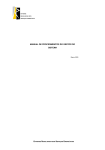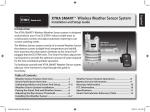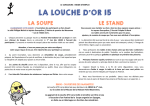Download pH-Xtra Glycolysis Assay
Transcript
H+ pH-Xtra™ Glycolysis Assay H For the measurement of Extracellular Acidification ILLUMINATING DISCOVERY ® + H+ H+ H+ pH-Xtra™ Glycolysis Assay H For the measurement of Extracellular Acidification For use with: ● Adherent cells; ● Suspension cells; ● Permeabilised cells; ● 3D cultures: tissues, spheroids, ● RAFT™ and scaffolds. + H+ H+ TABLE OF CONTENTS GENERAL INFORMATION ............................................................................................................................................ 03 MATERIALS SUPPLIED ........................................................................................................................................................ 03 STORAGE AND STABILITY .............................................................................................................................................. 03 ADDITIONAL ITEMS REQUIRED ............................................................................................................................... 03 OPTIONAL ITEMS NOT SUPPLIED ......................................................................................................................... 03 DESCRIPTION ............................................................................................................................................................................. 04 FLOW DIAGRAM ................................................................................................................................................................... 05 PLATE READER SET UP ..................................................................................................................................................... 06 MEASUREMENT PARAMETERS .................................................................................................................................. 06 INSTRUMENTS AND SETTINGS ................................................................................................................................. 06 SIGNAL OPTIMISATION..................................................................................................................................................... 07 PERFORMING THE OXYGEN CONSUMPTION ASSAY .............................................................. 08 CELL CULTURE AND PLATING .................................................................................................................................... 08 PRE-ASSAY PREPARATION ............................................................................................................................................. 08 TYPICAL ASSAY ........................................................................................................................................................................09 ANALYSIS ......................................................................................................................................................................................... 11 ASSESSING OXYGEN CONSUMPTION ............................................................................................................... 11 TITRATION OF CELL SEEDING DENSITY ........................................................................................................... 12 CELLULAR ENERGY FLUX ANALYSIS .................................................................................................................... 13 CALIBRATION OF PH-XTRATM GLYCOLYSIS ASSAY TO A PH [H+] SCALE .......................... 14 APPENDIX A - INSTRUMENT SETTINGS ...................................................................................................... 15 APPENDIX B - TROUBLE SHOOTING ........................................................................................................... 18 REFERENCES ................................................................................................................................................................................. 20 RELATED PRODUCTS .........................................................................................................................................................21 GENERAL INFORMATION MATERIALS SUPPLIED Assay kit will arrive at room temperature. For best results store as indicated below. Cat No. Item 96 well1. Quantity / Size Storage PH-100 pH-Xtra™ Reagent 1 vial +4°C RB-100 Respiration Buffer2. 1 tablet Room Temp STORAGE AND STABILITY The pH-Xtra™ reagent should be stored as follows: ● Dry material between +2 to +8°C (see Use Before date on vial). ● Reconstituted pH-Xtra™ reagent can be stored in the dark between +2 to +8°C for several days or reconstituted in water and stored as aliquots at -20°C for use within one month (avoid freeze thaw). The Respiration Buffer tablet should be stored as follows: Dry material at room temperature (see Use Before date on packaging) ● Reconstituted and filter sterilised product can be stored between +2 to +8°C. ● ADDITIONAL ITEMS REQUIRED Fluorescence plate reader, with suitable filter and plate temperature control. ● 96-well (black wall) clear bottom TC+ plates or standard PS plates for cell culture. ● OPTIONAL ITEMS NOT SUPPLIED Plate block heater for plate preparation ● 0.22μm sterilization filter, pH meter and acid / base for adjustment ● SUPPORT ● Visit our website www.luxcel.com. 1. 2. May also be used in a 384-well format, with one vial of reagent sufficient for ~ 200 wells. 1mM K-phosphate, 20mM Glucose, 70mM NaCl, 50mM KCl, 0.8mM MgSO4, 2.4mM CaCl2. P3 DESCRIPTION The pH-Xtra™ Glycolysis Assay from Luxcel Biosciences is an easy to use, highly flexible 96 or 384-well fluorescence-based approach for the direct, real-time, kinetic analysis of extracellular acidification rates (ECA/ECAR). As lactate production is the main contributor to this acidification, ECA measurements are a convenient and informative measure of cellular glycolytic flux. Such measurements offer an important insight into the central role played by altered glycolytic activity in a wide array of physiological and pathophysiological processes, including cellular adaptation to hypoxia and ischemia, and the development and progression of tumorigensis. The pH-Xtra™ reagent is chemically stable and inert, water-soluble and cell impermeable. It exhibits a positive signal response (increased signal with increased acidification) across the biological range (pH6-7.5), which, coupled with its spectral and response characteristics, make pH-Xtra™ the ideal choice for flexible, highthroughput assessment of ECA. This performance facilitates sensitive robust microtitre-plate based measurements, thereby overcoming many of the problems associated with the more cumbersome potentiometric pH approach. Rates of extracellular acidification are calculated from changes in fluorescence signal over time and, as the measurement is non-destructive and fully reversible (pH-Xtra™ reagent is not consumed), measurement of time courses and multiple drug treatments are possible. Luxcel's flexible plate reader format also allows multiparametric or multiplex combinations with Luxcel's other products and with other commonly available reagents, thereby facilitating parallel kinetic measurements of parameters such as ECA, mitochondria membrane potential ( Ѱm), O2 consumption or ROS generation, followed by end-point measure of parameters such as ATP content or cell membrane integrity, all on the same test cells. For example, the combination of Luxcel's MitoXpress® Xtra – Oxygen Consumption Assay (HS Method; Cat No. MX-200) and pH-Xtra™ Glycolysis Assay allows the simultaneous real-time measurement of the interplay between of mitochondrial respiration and glycolysis. This facilitates the determination of a cell’s metabolic phenotype and the quantification of perturbations in the balance between glycolysis and oxidative phosphorylation under various stimuli or pathological states. P4 Purge CO2 Resuspend Aliquot Read Figure 1: Flow diagram showing preparation and use of pH-Xtra™ Glycolysis Assay P5 PLATE READER SET-UP MEASUREMENT PARAMETERS pH-Xtra™ reagent is a chemically stable and inert, cell impermeable H+-sensing fluorophore. 7 6 0.8 Fold Increase Normalised Intensity 1 0.6 0.4 0.2 5 pH6.0 4 pH7.5 3 2 1 0 300 320 340 360 380 400 420 440 460 480 500 Wavelength (nm) 0 570 590 610 630 650 670 690 710 Wavelength (nm) Figure 2: Excitation and Emision spectra of pH-Xtra™. Left panel shows normalized excitation (Ex 340410nm; Peak 360-380nm). Right panel shows emission maxima (Em 590, 615 and 690nm) fold increase between pH6.0 and pH7.5 INSTRUMENTS AND SETTINGS Two fluorescence modalities1. can be optimally used with the pH-Xtra™ Glycolysis Assay, depending on plate reader type and instrument setup, as follows: 1 Standard: Time-resolved fluorescence measurement (TR-F), and 2 Advanced: Dual-read Ratiometric TR-F measurement (Lifetime calculation). 1. pH-Xtra™ Glycolysis Assay may also be used in non - TR-F intensity mode on some plate readers, although we recommend running the Signal Optimisation protocol and optimising cell seeding density. NOTE: Further details, including instrument, filter selection and measurement settings can be found in P6 Appendix A - Instrument Settings. SIGNAL OPTIMISATION - recommended for first time users NOTE: Use a plate block heater for plate preparation and pre-warm plate reader to measurement temperature. STEP 1: Reconstitute Respiration Buffer tablet in 50ml of water, warm to assay temperature (37°C), pH adjust to approx. pH7.4 and filter sterilise using a 0.22μm filter. Reconstitute (transparent) contents of the pH-Xtra™ vial in 1ml of Respiration Buffer, gently aspirating 3-4 times. NOTE: Reconstituted pH-Xtra™ reagent can be stored in the dark between +2 to +8°C for several days or stored as aliquots in water at 20°C for use within one month (avoid freeze thaw). STEP 2: Prepare 8 replicate wells of a 96-well plate, by adding 150μl pre-warmed Respiration Buffer to each well (A1-A4, B1-B4). STEP 3: Add 10μl reconstituted pH-Xtra™ reagent to 4 of the replicate wells (A1-A4) and 10μl Respiration Buffer to the remaining replicate wells (B1-B4). STEP 4: Read plate immediately in a fluorescence plate reader over 30 minutes (read every 2-3 minutes). STEP 5: Examine Signal Control well (A1-A4) and Blank Control well (B1-B4) readings (linear phase) and calculate S:B ratio. NOTE: For dual-read TR-F, calculate S:B for each measurement window. For most fluorescence TR-F plate readers, set up according to Appendix A - Instrument Settings, pH-Xtra™ should return a S:B ≥3. NOTE: See also Appendix B – Trouble Shooting. A 1 Respiration Buffer + pH-Xtra™ 2 Respiration Buffer + pH-Xtra™ 3 Respiration Buffer + pH-Xtra™ 4 Respiration Buffer + pH-Xtra™ B Respiration Buffer Respiration Buffer Respiration Buffer Respiration Buffer P7 PERFORMING THE GLYCOLYSIS ASSAY CELL CULTURE AND PLATING NOTE: Always leave two wells (H11 and H12) free from the addition of pH-Xtra™ reagent, as Blank Controls. ● ● For Adherent cells, seed cells in a 96-well plate at a density (typically 30,000 – 80,000 cells/well) in 200μl culture medium. NOTE: For new cell types, we recommend setting up a titration to select the optimum cell seeding density (see Figure 7). For Suspension cells, seed on the day of assay in 150μl culture medium at a density of approx. 250,000500,000 cells/well. Visit our website www.luxcel.com for more information on the use of pH-Xtra™ with a range of cell systems. PRE-ASSAY PREPARATION NOTE: Where cells are cultured in a CO2 incubator overnight, it is important to purge the media and plasticware of CO2 prior to conducting the pH-Xtra™ Glycolysis Assay as residual CO2 may contribute to acidification. Perform a CO2 purge, by incubating cells in a CO2 -free incubator at 37°C with 95% humidity, approx. 3 hours prior to performing the Glycolysis Assay measurement. ● Reconstitute Respiration Buffer tablet in 50ml of water, pH adjust to approx. pH7.4 and filter sterilise using a 0.22μm filter. Reconstitute transparent contents of the pH-Xtra™ vial in 1ml of Respiration Buffer, gently aspirating 3-4 times. NOTE: Reconstituted pH-Xtra™ reagent can be stored in the dark between +2 to +8°C for several days or stored as aliquots in water at -20°C for use within one month (avoid freeze thaw). ● Prepare test compounds, controls and dilutions as desired. Typical controls are oxamic acid (inhibitor; decrease ECA), FCCP (ETC uncoupler; increases ECA) and glucose oxidase (GOx; signal control). P8 NOTE: We recommend that all culture media and stock solutions to be used in the assay are pre-warmed at 37°C prior to use. Use a plate block heater for plate preparation and pre-warm the fluorescence plate reader to measurement temperature. Figure 3: Reconstitution of pH-Xtra™ vial TYPICAL ASSAY To assess Extracellular Acidification (ECA) or to investigate the effect of a treatment on glycolytic flux, cells are treated immediately prior to measurement. NOTE: We recommend the use of triplicate wells for each treatment. STEP 1: Remove spent culture medium from all assay wells and wash cells twice (2x), using 100µl of Respiration Buffer per well for each wash (Figure 4). After removing the second wash, replace with 150µl of fresh Respiration Buffer. NOTE: We recommend always leaving two wells (H11 and H12) free from the addition of pH-Xtra™ reagent, for use as Blank Controls. Add 150µl of Respiration Buffer to these Blank Control wells also. STEP 2: Add 10µl reconstituted pH-Xtra™ reagent to each well, except those wells for use as Blank Controls. Add 10µl of Respiration Buffer to these Blank Control wells. NOTE: If plating a full 96-well plate of assays, we recommend simplifying Step 1 and 2 by preparing a stock solution containing the 1ml of reconstituted pH-Xtra™ reagent added to 15ml pre-warmed Respiration Buffer, and using a multi-channel pipette to add 150µl of this diluted pH-Xtra™ stock to each well. Add 150µl of Respiration Buffer only (no pH-Xtra™) to each Blank Control well. Figure 4: Aliquoting fresh Respiration Buffer (+/- pH-Xtra™) P9 STEP 3: Test compound stock or vehicle (typically 1-10µl) may be added at this point if desired. NOTE: We recommend keeping the volume of added compound low to minimise any potential effects of solvent vehicle. STEP 4: Read the plate immediately in a fluorescence plate reader, with the set-up as described in Appendix A Instrument Settings (Figure 5). The plate should be measured kinetically for >120 minutes. When the measurement is completed, remove the plate and save measured data to file. Figure 5: Reading the assay plate Optional Controls Signal Controls: Leave 2 or 3 wells free from the addition of cells for use as Signal Control wells. Add 150µl of Respiration Buffer + 10µl of reconstituted pH-Xtra™ reagent to each well. ● Positive Signal Controls: Leave 2 or 3 wells free from the addition of cells for use as Positive Control wells. Add 150µl of fresh Respiration Buffer + 10µl of [1 mg/ml] glucose oxidase stock solution [in water] + 10µl reconstituted pH-Xtra™ reagent to each well. ● ● Negative Controls: To 2 or 3 wells containing cells, washed and refreshed with 150µl of Respiration Buffer, add 10µl of [750 mM] oxamic acid stock solution [in water] + 10µl reconstituted pH-Xtra™. P10 ANALYSIS NOTE: We recommend that all first time users perform a Signal Optimisation test, as described. Signal and Blank Control wells may also be included. ASSESSING EXTRACELLULAR ACIDIFICATION Plot the Blank Control well-corrected pH-Xtra™ Intensity or Lifetime values versus Time (Figure 6). Select the linear portion of the signal profile (avoiding any initial lag or subsequent plateau) and apply linear regression to determine the slope (ECA) and correlation coefficient for each well. NOTE: This approach is preferable to calculating a slope from averaged profiles. Lifetime Signal (µs) 550 500 GOx 450 Antimycin A 400 FCCP 350 Untreated 300 Oxamic Acid 250 200 0 30 60 90 120 150 180 Time (mins) Figure 6: Typical Lifetime profile of pH-Xtra™ for adherant cells, treated with typical control compounds, including oxamic acid recommended as a negative control. The effect of glucose oxidase as a positive signal control is illustrated schematically. NOTE: If using FCCP it is strongly recommended to perform a dose titration, since FCCP exhibits a bell-shaped dose response. Tabulate the slope values for each test sample, calculating appropriate average and standard deviation values across replicate wells. If optional Signal Control wells are included, the slope obtained for the Signal Control (sample without cells) should be subtracted from all test values. P11 Data analysis templates are available from some plate reader manufacturers, specifically configured to automate the analysis of Luxcel’s pH-Xtra™ Glycolysis Assay. Microsoft Excel templates are also available through our website www.luxcel.com. TITRATION OF CELL SEEDING DENSITY To determine an optimal cell seeding density for performing the pH-Xtra™ Glycolysis Assay, for new cell types, seed replicate wells with a range of seeding densities (typically 0, 10,000, 20,000, 40,000, 60,000 and 80,000 cells/well). Plot the data generated as a function of intensity or Lifetime values versus time, as illustrated (Figure 7). 350 80,000 330 Lifetime (µs) 310 60,000 290 270 40,000 250 230 210 20,000 190 10,000 0 170 150 0 30 60 90 120 150 180 Time (mins) Figure 7: Extracellular Acidification rate profiles (ECA) are shown for A549 cells seeded at 0, 10,000, 20,000, 40,000, 60,000 and 80,000 cells/well. In this experimental example, a seeding density of 40,000 cells/well was chosen for study as this provided a suitable balance between ECA response and cell availability. P12 CELLULAR ENERGY FLUX ANALYSIS Multiparametric (or multiplex) combination of pH-Xtra™ Glycolysis Assay together with Luxcel's MitoXpress® Xtra - Oxygen Consumption Assay [HS Method] (Cat No: MX-200) allows the simultaneous real-time measurement of glycolysis and mitochondrial respiration, and analysis of the metabolic phenotype of cells and the shift (flux) between the two pathways under pathological states (Figure 8). 600 500 ATP Oxygen % Effect 400 Consumption 300 Glycolysis 200 100 0 Rotenone Antimycin FCCP Oxamate Untreated Figure 8: Cellular Energy Flux for HepG2 cells, treated with a combination of drug compounds modulating the ETC or inhibiting lactate production, shown as a percentage relative to untreated control cells. Comparative measurements with pHXtra™ (glycolysis) and MitoXpress® Xtra (oxygen consumption), show the shift between glycolysis and mitochondrial respiration and the cellular control of energy (ATP; measured 1h post-treatment using Promega Cell Titer-Glo®). P13 CALIBRATION OF pH-XTRA™ GLYCOLYSIS ASSAY TO A pH [H+] SCALE It is possible to express Extracellular Acidification (ECA) as a function of pH [H+] versus time. This is achieved by first creating a calibration standard curve, by measuring TR-F intensity or preferably Lifetime values (selecting stabilised readings over a 30 minute read), from a range of pH-buffered standards at the appropriate assay temperature (see Figure 9). Select the linear portion of the standard curve and apply linear regression to determine the calibration function (See Hynes et al., 2009). 5550 00 4500 50 450 Lifetime (µs) 400 400 350 350 300 300 250 250 2200 00 30°C 37°C 1150 50 1100 00 5.5 6 6.5 7 7.5 pH Figure 9: pH-XTRA™ reagent calibration in Lifetime scale, at 30°C and 37°C using pH-buffered PBS, at increments of 0.2 across a pH range 6.0 - 7.5. P14 APPENDIX A - INSTRUMENT SETTINGS Two fluorescence modalities1. can be optimally used with the pH-Xtra™ Glycolysis Assay, depending on plate reader type and instrument setup. NOTE: We strongly recommend only using fluorescence plate readers equipped with temperature control. Standard: TR-F Measurement Measurement using time-resolved fluorescence (TR-F) provides flexibility to use a wide range of commonly available plate readers2.. TR-F measurement reduces non-specific background and increases probe sensitivity. Optimal delay time is ~100µs and gate (integration) time is 100µs. NOTE: pH-Xtra™ should return a S:B ≥3. Advanced: Dual-Read TR-F (Lifetime) Optimal performance can be achieved using dual-read TR-F in combination with subsequent ratiometric Lifetime calculation, to maximise dynamic range (Figure 10) and to express ECA as a function of [H+]. NOTE: pH-Xtra™ should return a S:B ≥10. Optimal dual-delay and gate (integration) times: ● Integration window 1: 100µs delay (D1), 30µs measurement time (W1) ● Integration window 2: 300µs delay (D2), 30µs measurement time (W2) 1. pH-Xtra™ Glycolysis Assay may also be used in non - TR-F Intensity mode on some plate readers, although we recommend running the Signal Optimisation protocol to confirm an acceptable S:B, and optimising cells seeding density (Figure 7). 2. Users may see better performance using filter-based plate readers. P15 Intensity Intensity DUAL-READ TR-F AND LIFETIME ILLUSTRATED Dual-read TR-F and subsequent Lifetime calculation allows measurement of the rate of fluorescence decay of the pH-Xtra™ reagent, and can provide measurements of extracellular acidification that are more stable and with a wider dynamic range than measuring signal Intensity or standard TR-F. NOTE: S:B for Integration window 2 is recommended to be ≥10 to allow accurate Lifetime calculation. W1 W2 100μs 30μs D1 300μs Time D2 30μs Time Figure 10: Illustrating dual-read TR-F measurement. Use the dual intensity readings to calculate the corresponding Lifetime (μs) using the following transformation: Lifetime (μs)[τ] =(D2-D1)/ln(W1/W2) Where W1 and W2 represent the two (dual) measurement windows and D1 and D2 represent the delay time prior to measurement of W1 and W2 respectively. This provides Lifetime values in microsecond units (µs) at each measured time point for each individual sample (Figure 10). NOTE: Lifetime values should be in the range ~200µs for cells assayed in respiration buffer at approx pH7.4, increasing up to >400μs upon acidification, and should only be calculated from samples containing pH-Xtra™ reagent. Lifetime values should not be calculated from blank wells. P16 RECOMMENDED INSTRUMENT AND MEASUREMENT SETTINGS Instrument Optical Configuration Filter-based Top or bottom read Integration 1 Mode*** (D1 / W1) Integration 2 (D2 / W2) 100 / 30μs Dual-read TR-F 300 / 30μs (Lifetime) BMG Labtech:* FLUOstar Omega POLARstar Omega BMG Labtech:* CLARIOstar** BMG Labtech:* PHERAstar FS BMG Labtech:* FLUOstar Optima / POLARstar Optima Perkin Elmer: VICTOR series / X4, X5 Perkin Elmer: EnVision Perkin Elmer: EnSpire BioTek:* Synergy H1, H4, HT, Neo, 2 Cytation 3** BioTek: MX, H1m Tecan: Infinite / Safire / Genios Pro Mol. Devices: SpectraMax / Flexstation / Gemini Ex 340 ± 50nm (TR-EX L) Em 615 ± 10nm (BP-615) Hybrid - filter based Top or bottom read Filter-based Top read (HTRF Module) Filter-based Top or bottom read 100 / 30μs 300 / 30μs 100 / 30μs 300 / 30μs 100 /100μs n/a Dual-read TR-F (Lifetime) Dual-read TR-F (Lifetime) TR-F Ex 340 ± 40nm Em 620 ± 10nm Ex 337nm Em 620nm Ex 340 ± 50nm (TR-EX L) Em 615 ± 10nm (BP-615) Filter-based Top read Filter-based Top read Monochromator Top or bottom read Filter-based Top or bottom read 100 / 30μs 300 / 30μs 100 / 50μs 300 / 50μs 100 /100μs n/a 100 /30μs 300 / 30μs Dual read TR-F (Lifetime) Dual-read TR-F (Lifetime) TR-F Ex 340 ± 40nm (D340) Em 615 ±8.5nm (D642) Ex 340 ± 60nm (X340) Em 615 ±8.5nm (M615) Ex 380nm Em 615nm Ex 360 ±40nm Em 620 ± 10nm Monochromator Top or bottom read Filter-based/Monochromator Top or bottom read 100 /100μs n/a 100 /100μs n/a TR-F Monochromator-based Top or bottom read 50 / 250μs n/a Dual read TR-F (Lifetime) TR-F TR-F Ex (nm) Em (nm) Ex 380nm Em 615nm Ex 380 ± 20nm Em 615 ± 10nm Ex 380nm Em 615nm Notes: * Assay-specific protocols and notes are available from manufacturer for pH-XtraTM ** Assay-specific protocols in development (contact [email protected]) *** Where TR-F indicated, a TR-F module must be installed Note: Choose filter based optical configuration where available. Instruments with recommended Dual read TR-F measurement mode can alternatively be set up using Standard TR-F measurement mode if desired. P17 APPENDIX B – TROUBLE SHOOTING Extensive literature, including application notes, videos, publications and email technical support is also available through our website www.luxcel.com. GENERAL NOTES AND RECOMMENDATIONS Storage and Stability: On receipt the pH-Xtra™ reagent should be stored between +2 to +8°C (see Use Before date on vial). Reconstituted pH-Xtra™ reagent can be stored in the dark between +2 to +8°C for several days or stored as aliquots in water at -20°C for use within one month (avoid freeze thaw). Note: pH-XtraTM reagent diluted in Respiration Buffer / media should be used on the same day. Respiration Buffer: Kit contains a single Respiration Buffer tablet sufficient for 50ml 1x stock, containing 1mM K-phosphate, 20mM Glucose, 70mM NaCl, 50mM KCl, 0.8mM MgSO4, 2.4mM CaCl2. Alternative media and supplements may be used as required (such as unbuffered DMEM), so long as care is taken to ensure a minimal buffering capacity. Plate Reader: A fluorescence plate reader capable of measuring excitation between 360nm and 390nm (see Figure 2) and emission at 615nm, and having plate temperature control is required. We strongly recommend using TR-F measurement. Temperature: We recommend the use of a plate block heater for plate preparation, to maintain a temperature of 37°C. Pre-warm the fluorescence plate reader to measurement temperature and ensure that all culture media and stock solutions to be used in the assay are pre-warmed at 37°C prior to use. Signal Optimisation and Use of Controls: We recommend performing a signal optimisation check, especially for first time users, and inclusion of blank and optional additional control wells as described. General Assay Set-Up, Pipetting and Aspirating: Prepare your assay, materials and work space in advance. Take care not to disrupt the cell monolayer (adherent cells) during pipetting and aspirating. Work rapidly once the pH-Xtra™ reagent has been added, to reduce the potential for assay variability. Re-check pH of Respiration Buffer prior to use. Cell Type and Cell Density: Since the pH-Xtra™ reagent measures Extracellular Acidification, the amount of signal change will be directly dependent on the rate of glycolytic flux of the cell type being measured. We recommend using a medium to high cell density per well as a starting point, and reducing cell numbers as P18 required. (See Figure 7). SIGNAL TO BLANK (S:B) OPTIMISATION For most fluorescence plate readers, set up according to Appendix A - Instrument Settings, pH-Xtra™ should return a S:B ratio ≥3. The following options may be helpful to improve S:B if the ratio is not as high as expected: 1 2 3 4 5 6 Increase Gain (PMT) setting or flash energy Adjust TR-F focal height Increase length of integration time, the same for both delay windows. Repeat as top or bottom-read, respectively. Increase volume of pH-Xtra™ (15µl). Contact Instrument Supplier for further options. FREQUENTLY ASKED QUESTIONS: Q: What do I do if I cannot detect detect any any signal signal in in wells wells containing containingcells cellsand andpH-Xtra pH-Xtra™™(or (orI Ican candetect detectaasignal signal but the slope (rate) appears very low)? A: Check correct GOx control correct Instrument Instrument Settings Settings(Appendix (AppendixA) A)- -Perform PerformSignal SignalOptimisation Optimisation- Include - Include GOx control (max signal) - Increase cell cell density. density. Check CheckpH pHof ofpre-warmed pre-warmedRespiration RespirationBuffer Bufferand andcorrect correctasasnecessary, necessary, as pH can drift over time. If tested and not resolved, contact [email protected] ™ ™ , but thethe slope (rate) fallsfalls Q: What do containing cells andand pH-Xtra do II do doififI Ican candetect detecta asignal signalininwells wells containing cells pH-Xtra , but slope (rate) initially or is variable from well to well? A: Check cell plate, instrument andand all all cell seeding seeding and andpipetting pipettingconsistency consistency- -Increase Increasecell celldensity density- Ensure - Ensure plate, instrument culture media and stock solutions are pre-warmed at 37°C prior to use - Reduce plate preparation times. NOTE: Some plate readers have inconsistent temperature control. If you suspect this to be the case, consider: – Reduce assay (and equilibration) temperatures to 30°C and avoid outer wells. If tested and not resolved, contact [email protected]. P19 REFERENCES A high-throughput dual parameter assay for assessing drug-induced mitochondrial dysfunction provides additional predictivity over two established mitochondrial toxicity assays. Hynes J et al, Toxicol In Vitro., 2012 Mar; 27(2): 560-569 Comparative bioenergetic assessment of transformed cells using a cell energy budget platform. Zhdanov AV et al, lntegr. Biol., 2011; 3: 1135-1142 Fluorescent pH and oxygen probes of the assessment of mitochondrial toxicity in isolated mitochondria and whole cells. Hynes J et al, Curr Protoc Toxicol., 2009 May; Chapter 2: Unit 2.16 In vitro analysis of cell metabolism using a long-decay pH-sensitive lanthanide probe and extracellular acidification assay. Hynes J et al, Analytical Biochemistry., 2009; 390: 21-28 P20 RELATED PRODUCTS ● ● ● ® MitoXpress Xtra - Oxygen Consumption Assay [HS Method] (Cat No. MX-200) MitoXpress® Intra – Intracellular O2 Assay (Cat No. MX-300) GreenLight® 960 – Microbial Detection Assay (Cat No. GL-960) P21 Luxcel Biosciences Limited Suite 2.04 Western Gateway Building Western Road Cork Ireland t +353 (0)21 420 5348 e [email protected] w www.luxcel.com
























